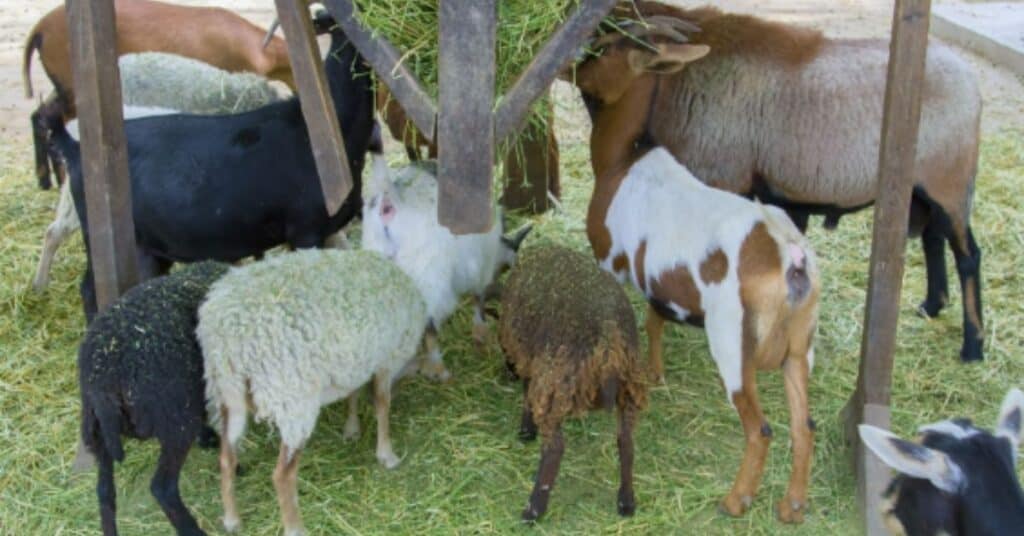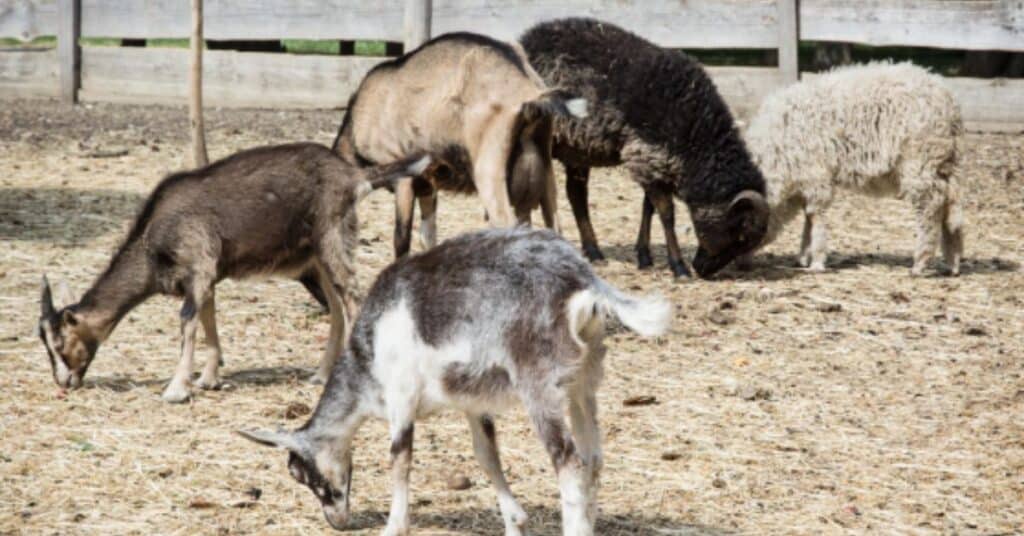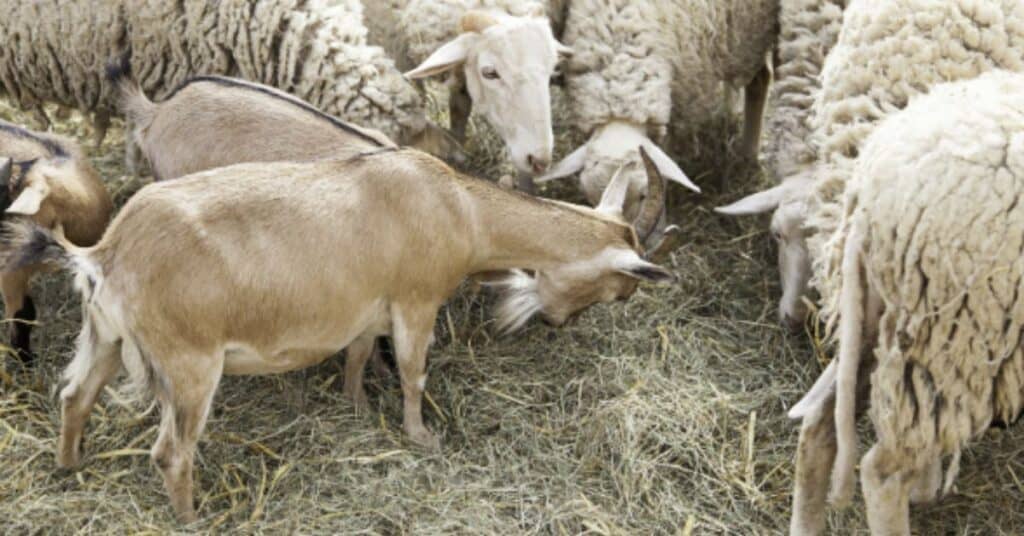The answer is Yes. Goats and sheep and be raised together. Some people started with goat farming, and along the line, they started raising Sheep, so they wondered if they could add Sheep to the goats to share the same pasture, feed and shelter. Well, the excellent news is, yes, it can be done.
Both goats and sheep have similar characteristics, they are both ruminants and members of the Bovidae family and Caprinae subfamily, and they both have similar economic value as they can be both raised for the producing milk, meat, and wool.
When I first began animal husbandry, I was raising goats before I realized I needed to introduce Sheep into the pasture. Because I had limited pasture then, I began with a few sheep and wondered how they would behave, if they would attack each other or be friends.
I never witnessed any hostility between the two species after raising them together, but the goats were larger and more robust than the Sheep. As for their dietary habits, goats are browsers, while Sheep, like cows, are grazers.
Sheep consume grass and broad-leaved plants, whereas goats consume whatever they come upon, including grass, brush, leaves, trees, and bushes.
The good news is that goats and sheep do not fight for the same resources since goats like to eat tall grasses and trees, whereas sheep prefer to eat vegetation closer to the ground. However, because their grazing rates are varied, one species may not feed to capacity.
Before you decide to raise both goats and sheep together, there are some things you need to put into consideration for the safety and well-being of the animals.
Nutritional needs:

Photo By Andrey, Canva
The feeding of goat and sheep are almost the same, but you will have to deal with mineral requirements for both animals. Goats require copper supplements in a much higher quantity, but sheep do not require a minimal amount of copper.
Copper can be toxic to Sheep; when Sheep consumes too much copper, it may cause death. Since Both animals will require vitamin and mineral supplementation, but the goat requires a diet high in copper, while sheep are susceptible to a copper overdose. Hence, you have to be careful when feeding them.
To get over this huddle, you can feed both animals a general feed that does not contain copper. You can build a small structure on the land with considerable height where you can place the copper supplements, the goats can climb to eat the supplements, and since Sheep hardly climb, it would be difficult for the Sheep to consume these supplements.
You may also feed the goat and the Sheep separately by building two separate feeding structures and buying a specie- specific feed.
Shelter:

Photo By Vrabelpeter, Canva
The shelter requirements for both animals are generally the same, although goats are curious. Natural explorers, compared to Sheep, tend to climb fences made for sheep and escape from the farm environment, but sheep do not wander off.
Fencing is done to keep predators away than preventing the sheep from wandering, so if you are to keep both goats and sheep in the same pastures, it is recommended that you construct the fencing a little higher because of the goats. Also, goats and sheep hate the wet environment.
You will see them fold up, feeling cold whenever it rains, but the goats hate rain the most, so it is important to build a good shield in the pasture where they can stay away from dampness or rain.
Diseases:
Another factor you need to consider when raising goats and sheep together is the fact that they can easily transmit parasites and diseases to each other. Since sheep and goats share the same parasites, it is known that goats are more susceptible to internal parasites than sheep.
You have to ensure that you use a clean pasture to control the parasites that is a pasture that has not been used for 6 to 12 months. Another form of clean pasture is a pasture grazed by cattle or horses since Sheep and goats do not share the same parasites as cattle or horses.
Rotating the grazing areas and deworming can also help reduce the problems of parasites and diseases. Getting the animals vaccinated can also be of help.
Preventing Geep:
Geep is the name given to the offspring resulting from a cross between a sheep and a goat; it is a sheep-goat hybrid.
Although sheep and goats are similar as they belong to the same family of Bovidae and subfamily of Caprinae, we must remember that they belong to different genera. Goats belong to the genus Capra and have 60 chromosomes, while Sheep belong to the genus Ovis and have 54 chromosomes, so there is usually a problem when cross-breeding them, which often ends up in a stillborn.
The offspring of interbreeding (Geep) have a short lifetime and frequently die at birth. Eliminating the risk of interbreeding by isolating the animals throughout the breeding season.
How Many Sheep & Goats can you raise together Per Acre?
According to experts, one goat needs a space of 10 square feet indoors and 200 square feet outdoors, so you will need to raise between 6 to 8 goats per acre of farmland, but when you are mixing goats with Sheep, you may still decide to maintain that number or increase it a little bit like 8 to 10 goat-sheep per acre.
You may want to ask how big an acre of farmland is; one acre of land is equal to 43,560 Square feet or 4,046 Square meters. This is almost the size of a football field.
You may be wondering why they need so much space, well, you will have to arrange for grazing and browsing, and they need space to roam for their overall well-being.
Generally, goats need more space than Sheep because goats are more susceptible to parasites than Sheep, so they need to maintain considerable distances to avoid being infected with parasites.
In my case, I could have four goats and three Sheep in almost half acre of land because I had limited pasture, but I do not encourage you to do that as you have to avoid overcrowding by all means.
CONCLUSION:
Suppose you already own sheep and you are thinking of adding goats to the pasture. In that case, you may need to reconsider. It is generally not recommended that you keep goats and sheep in the same shelter or raise them together in the same pasture because of the above difficulties you may encounter. However, if you have a small farmland, you can implement the safety or solutions to the problems above. You may decide to raise both animals together but try to do that with a small number. Hence, to minimize the risk involved in raising both species together.

